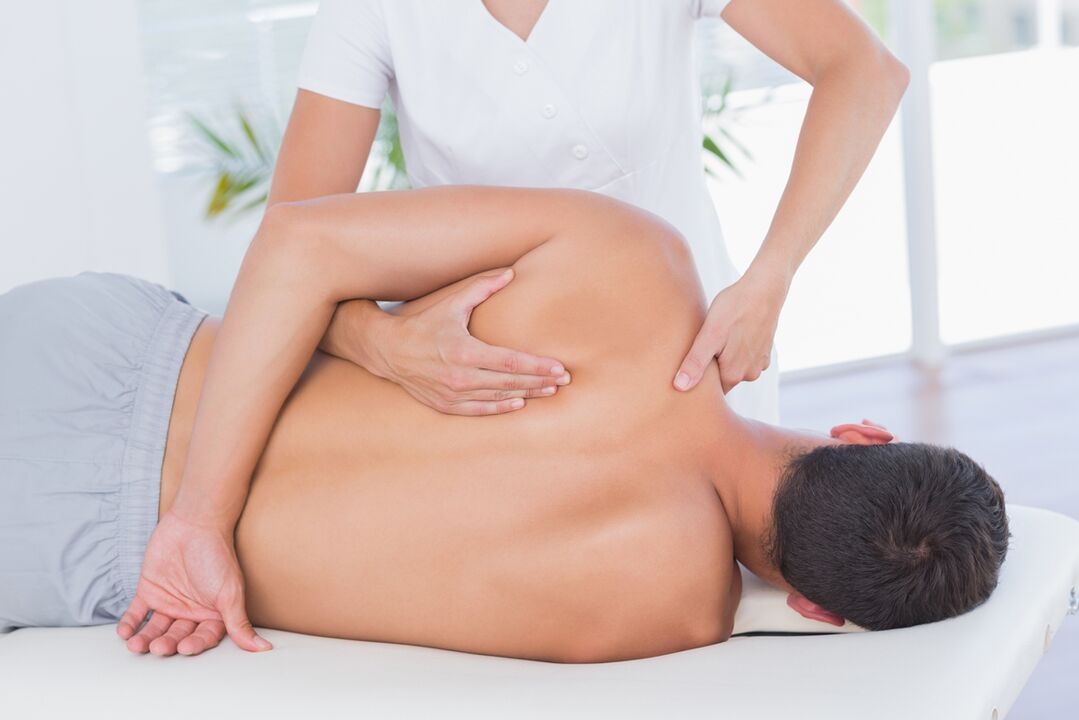Pain under the left shoulder blade in the back of the back is a symptom that occurs in both old and young people. Muscle tension after physical exertion or chronic curvature can cause discomfort. The concentration of back pain from behind not only indicates diseases of the musculoskeletal system: problems with the organs of the chest and abdominal cavity are possible. If the discomfort under the scapula on the left side increases, it is necessary to consult a specialist.

Anatomical features
The scapula is closely related to the clavicle, forming the clavicle-scapular joint. On several sides, the costal arches and the vertebral axis are attached to the shoulder blades. The listed bone formations retain the shape of the chest and back.
The lungs and heart are at the level of the thoracic segment of the spine. Problems with these organs can cause pain. Also, discomfort occurs due to pinching of the nerve roots of the spinal cord, located in the spinal canal (next to the shoulder blades).
Causes of discomfort in the scapula area
There are 5 main groups of causes of pain:
- Diseases of the musculoskeletal system: variants of intercostal neuralgia, arthritis of the shoulder joint, neoplasms. Degenerative-dystrophic changes in the vertebral axis - osteochondrosis, hernias, protuberances, myositis - can also become a provoking factor.
- Cardiovascular diseases: angina pectoris, myocardial infarction, infections of the heart layers (myocarditis, pericarditis, endocarditis).
- Pathologies of the bronchopulmonary system: bronchitis, inflammation of the lungs or pleura, tuberculosis.
- Gastrointestinal problems: chronic pancreatitis, peptic ulcer, spleen injury.
- Damage to the scapula of various origins: trauma, inflammation, tuberculosis.
How to get rid of pain on the left side of the back under the scapula
If the diagnosis has already been confirmed by a doctor (osteochondrosis or chronic pancreatitis), it is necessary to adhere to the recommendations previously given.
Musculoskeletal disorders in the acute stage require the use of analgesics and anti-inflammatory drugs. Care should be taken when using warming ointments: apply the drug strictly to the scapular region, without affecting the projection of the heart. Otherwise, you can cause a rapid heart attack and rhythm disturbance.
In chronic pancreatitis or peptic ulcer, a special diet is required, taking enzymes or anti-ulcer drugs according to the scheme.
Any discomfort forces you to reduce physical activity: the patient is resting. For sleeping, it is recommended to choose an orthopedic pillow and mattress.
Important! If the pain under the left scapula persists with a change in body position and does not subside with rest, you should urgently see a doctor to rule out acute myocardial infarction.
Possible illnesses
The list of diseases accompanied by painful symptoms:
- Bursitis- inflammation of the periarticular shoulder bag. Due to injury or excessive loads, soft tissues swell, pressure occurs on neighboring muscles, ligaments and tendons. The unpleasant sensations when raising the hand gradually turns into an acute pain syndrome, which manifests itself even in a dream. Bacterial (septic) bursitis is a consequence of infection of the mucous membrane. It is characterized by an increase in temperature, redness of the skin of the shoulder, severe pain.
- Osteochondrosis of the thoracic region.Degenerative changes in the structure of intervertebral discs provoke muscle spasms, pinching of nerve roots, vascular bundles. The clinical picture begins with a slight tingling sensation in the chest or back. The increasing discomfort is accompanied by loss of sensitivity of the fingers and shoulder girdle.
- Intervertebral hernia.The destruction of the cartilage capsule of the intervertebral nucleus has more pronounced clinical manifestations. There is paresis and paralysis of the upper limbs. Growing herniated discs are often complicated by mild to moderate neuropathic pain. The peculiarity of these pains is the lack of effect on the background of taking nonsteroidal anti-inflammatory drugs.
- Myositis.Inflammatory process of skeletal muscles resulting from infections or trauma. The most serious form of the disease is ossification of the subscapularis muscles (ossification of muscle tissue).
- Angina pectoris- a pathological condition accompanied by a deficit of blood supply to the heart muscle. Angina pectoris is characterized by back pain under the left scapula, sharp spasmodic pain behind the breastbone. Severe stress, smoking, alcohol abuse cause an attack.
Diagnostic
Western medicine turns to the help of hardware diagnostics in order to rule out problems with the musculoskeletal system. To make a definitive diagnosis, the patient must undergo:
- X-ray of the cervical and thoracic spine.
- Ultrasound for bursitis shows excess fluid in the synovial joint capsule.
- Computed tomography.
- Magnetic resonance imaging.
If a patient is suspected of having myositis, a detailed blood test is required to confirm the inflammatory process.
If cardiac pathology is suspected, allopathic people perform the following examination methods:
- Electrocardiogram.
- A blood test that determines the factors of myocyte necrosis.
- Ultrasound of the heart.
Treatment and prevention of disease
Therapies and dosages differ depending on the form of the disease and the severity.
- The pathology of the musculoskeletal system requires the appointment of nonsteroidal anti-inflammatory drugs (for pain relief), muscle relaxers, vitamin complexes. In difficult clinical cases, Western doctors recommend eliminating the pain syndrome with hormonal agents. Minimally invasive shoulder surgery is often used to treat bursitis.
- Myositis is treated with warming gels and ointments, anti-inflammatory drugs. Physiotherapy is recommended in remission. With severe pain, allopaths block novocaine.
- Angina attacks are stopped by nitrate-type compounds. According to medical protocols, patients need injections of anticoagulant drugs to prevent blood clots. With high blood pressure, patients take antihypertensive pills. To normalize the rhythm, doctors prescribe antiarrhythmics. They also recommend taking cholesterol lowering drugs, metabolic therapy.































